load capacity CHEVROLET ASTRO 2003 Owners Manual
[x] Cancel search | Manufacturer: CHEVROLET, Model Year: 2003, Model line: ASTRO, Model: CHEVROLET ASTRO 2003Pages: 386, PDF Size: 17.31 MB
Page 124 of 386
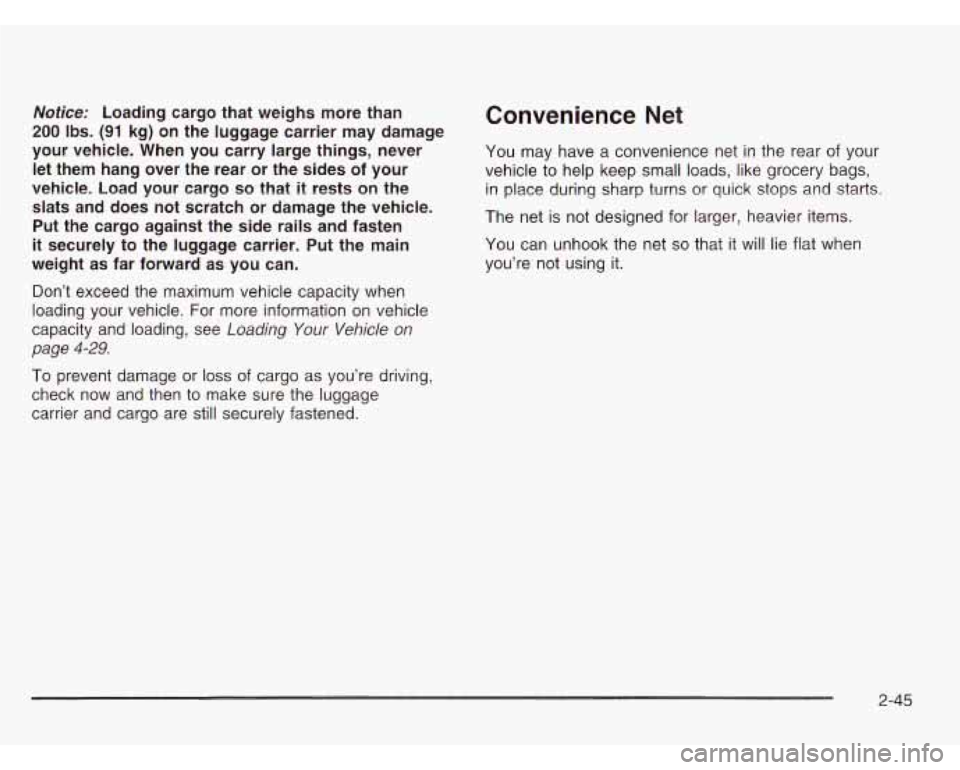
Notice: Loading cargo that weighs more than
200 Ibs. (91 kg) on the luggage carrier may damage
your vehicle. When you carry large things, never
let them hang over
the rear or the sides of your
vehicle. Load your cargo
so that it rests on the
slats and does not scratch or damage the vehicle. Put the cargo against the side rails and fasten
it securely to the luggage carrier. Put the main
weight as far forward as you can.
Don’t exceed the maximum vehicle capacity when
loading your vehicle. For more information on vehicle
capacity and loading, see
Loading Your Vehicle on
page 4-29.
Convenience Net
You may have a convenience net in the rear of your
vehicle to help keep small loads, like grocery bags,
in place during sharp turns or quick stops and starts.
The net is not designed for larger, heavier items.
You can unhook the net
so that it will lie flat when
you’re not using
it.
To prevent damage or loss of cargo as you’re driving,
check now and then to make sure the luggage
carrier and cargo are still securely fastened.
2-45
Page 204 of 386
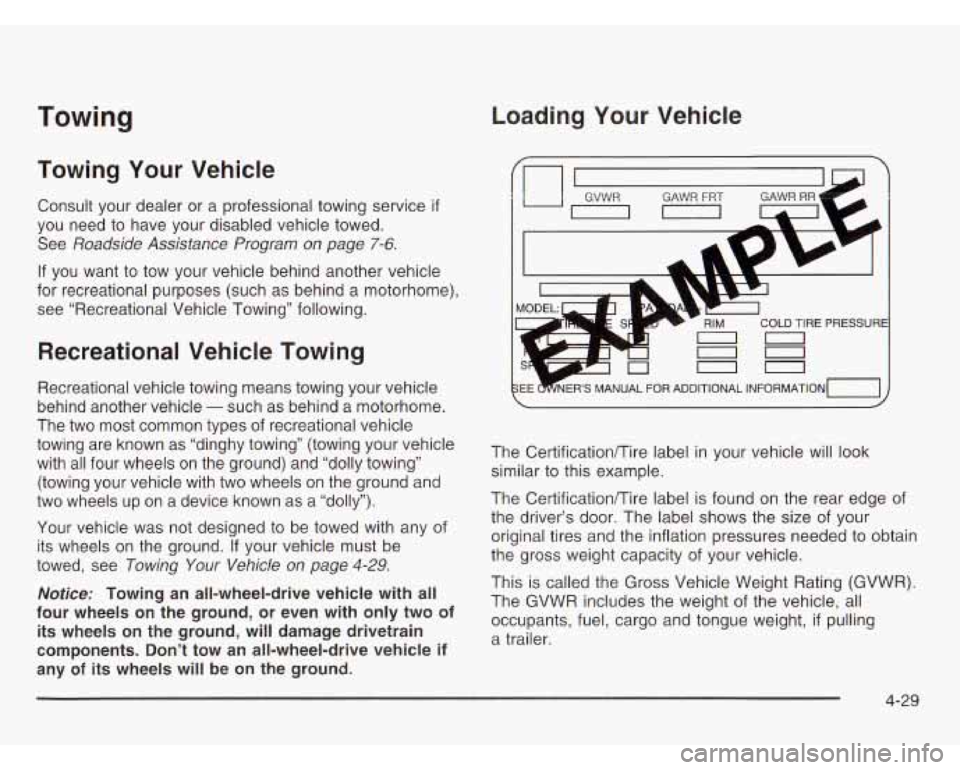
Towing Loading Your Vehicle
Towing
Your Vehicle
Consult your dealer or a professional towing service if
you need to have your disabled vehicle towed.
See
Roadside Assistance Program on page 7-6.
If you want to tow your vehicle behind another vehicle
for recreational purposes (such as behind a motorhome),
see “Recreational Vehicle Towing” following.
Recreational Vehicle Towing
Recreational vehicle towing means towing your vehicle
behind another vehicle
- such as behind a motorhome.
The two most common types
of recreational vehicle
towing are known as “dinghy towing” (towing your vehicle
with all four wheels on the ground) and “dolly towing”
(towing your vehicle with two wheels on the ground and
two wheels up on a device known as a “dolly”).
Your vehicle was not designed to be towed with any
of
its wheels on the ground. If your vehicle must be
towed, see
Towing Your Vehicle on page 4-29.
Notice: Towing an all-wheel-drive vehicle with all
four wheels on the ground, or even with only two
of
its wheels on the ground, will damage drivetrain
components. Don’t tow an all-wheel-drive vehicle
if
any of its wheels will be on the ground.
1 I GWVR GAWR FRT GAWR RR 1
COLD TIRE PRESSURI
DO nn
NERS MANUAL FOR ADDITIONAL INFORMATION^ I
The Certificationflire label in your vehicle will look
similar to this example.
The Certificationflire label is found on the rear edge of
the driver’s door. The label shows the size
of your
original tires and the inflation pressures needed to obtain
the gross weight capacity of your vehicle.
This is called the Gross Vehicle Weight Rating (GVWR).
The GVWR includes the weight of the vehicle, all
occupants, fuel, cargo and tongue weight,
if pulling
a trailer.
4-29
Page 206 of 386
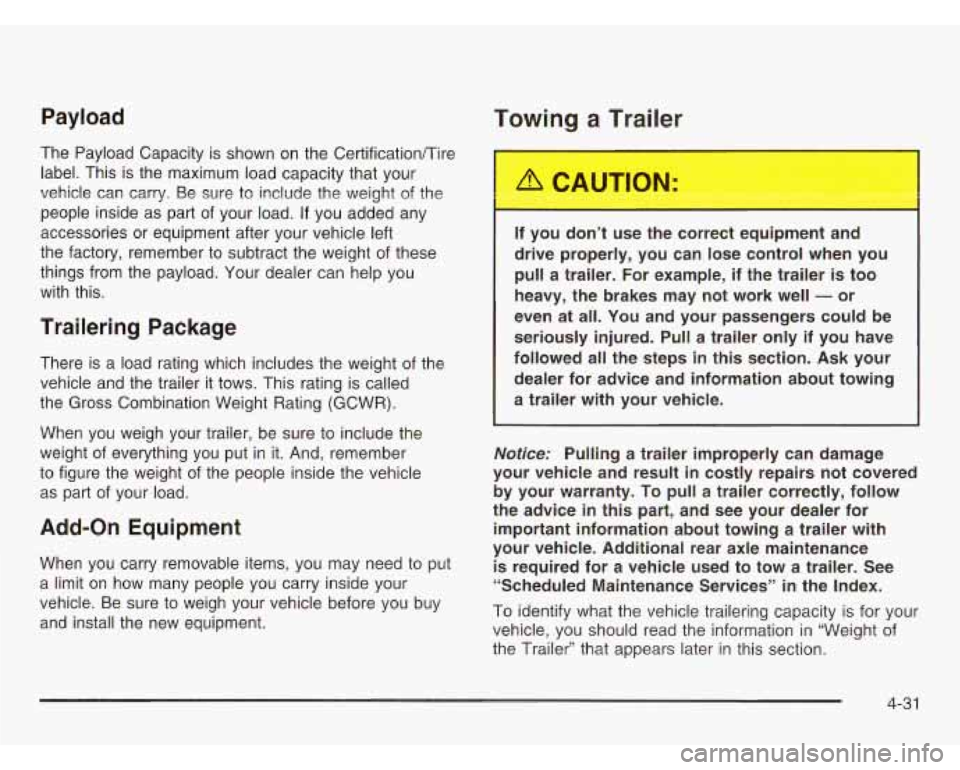
Payload
The Payload Capacity is shown on the CertificationiTire
label. This is the maximum load capacity that your
vehicle can carry. Be sure to include the weight of the
people inside as part of your load.
If you added any
accessories or equipment after your vehicle left
the factory, remember to subtract the weight of these
things from the payload. Your dealer can help you
with this.
Towing a Trailer
Trailering Package
There is a load rating which includes the weight of the
vehicle and the trailer it tows. This rating is called
the Gross Combination Weight Rating (GCWR).
When
you weigh your trailer, be sure to include the
weight of everything you put in it. And, remember
to figure the weight of the people inside the vehicle
as part of your load.
Add-on Equipment
When you carry removable items, you may need to put
a limit on how many people you carry inside your
vehicle. Be sure to weigh your vehicle before you buy
and install the new equipment. If
)“J don’t use the correct equipment and
drive properly, you can lose control when you pull a trailer. For example, if the trailer
is too
heavy, the brakes may not work well
- or
even at all. You and your passengers could be
seriously injured. Pull a trailer only if you have
followed all the steps in this section.
Ask your
dealer for advice and information about towing
a trailer with your vehicle.
Notice: Pulling a trailer improperly can damage
your vehicle and result in costly repairs not covered by your warranty.
To pull a trailer correctly, follow
the advice
in this part, and see your dealer for
important information about towing a trailer with
your vehicle. Additional rear axle maintenance is required for a vehicle used to tow a trailer. See
“Scheduled Maintenance Services”
in the Index.
To identify what the vehicle trailering capacity is for your
vehicle, you should read the information in “Weight of
the Trailer” that appears later in this section.
4-3 1
Page 210 of 386
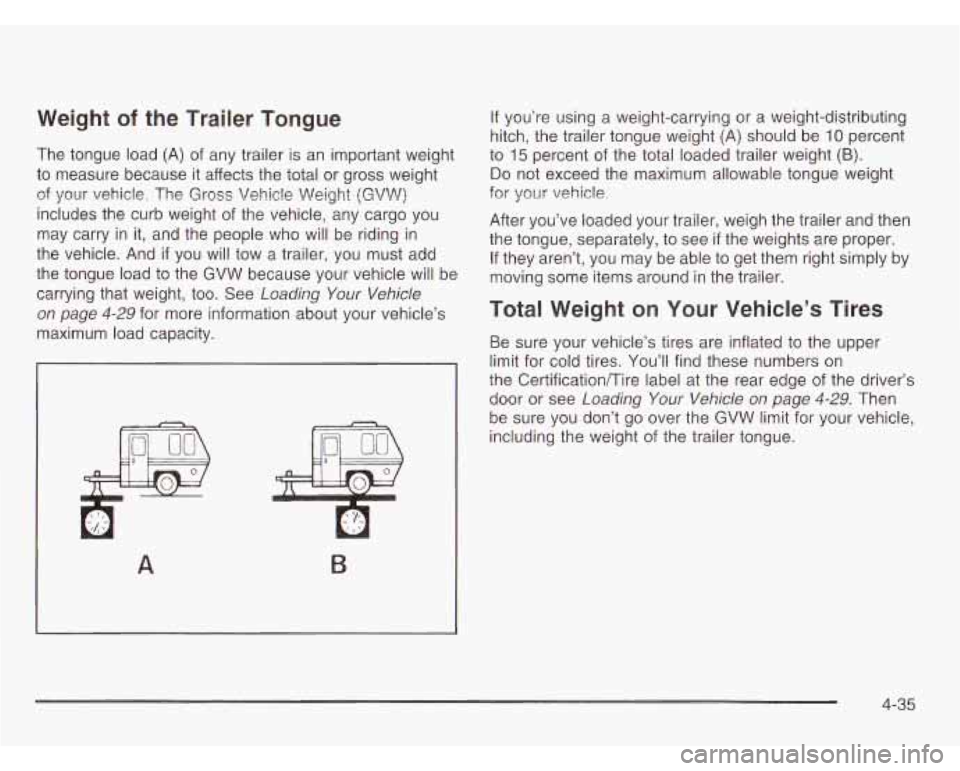
Weight of the Trailer Tongue
The tongue load (A) of any trailer is an important weight
to measure because it affects the total or gross weight
of your vehicle. The
Gross Vehicle Weight (GVW)
includes the curb weight of the vehicle, any cargo you
may carry in it, and the people who will be riding in
the vehicle. And
if you will tow a trailer, you must add
the tongue load to the
GVW because your vehicle will be
carrying that weight, too. See
Loading Your Vehicle
on page
4-29 for more information about your vehicle’s
maximum load capacity.
A B
If you’re using a weight-carrying or a weight-distributing
hitch, the trailer tongue weight (A) should be
10 percent
to
15 percent of the total loaded trailer weight (B).
Do not exceed the maximum allowable tongue weight
for your vehicle.
After you’ve loaded your trailer, weigh the trailer and then
the tongue, separately, to see
if the weights are proper.
If they aren’t, you may be able to get them right simply by
moving some items around in the trailer.
Total Weight on Your Vehicle’s Tires
Be sure your vehicle’s tires are inflated to the upper
limit for cold tires.
You’ll find these numbers on
the Certificationflire label at the rear edge of the driver’s
door or see
Loading Your Vehicle on page 4-29. Then
be sure you don’t go over the GVW limit for your vehicle,
including the weight of the trailer tongue.
4-35
Page 286 of 386
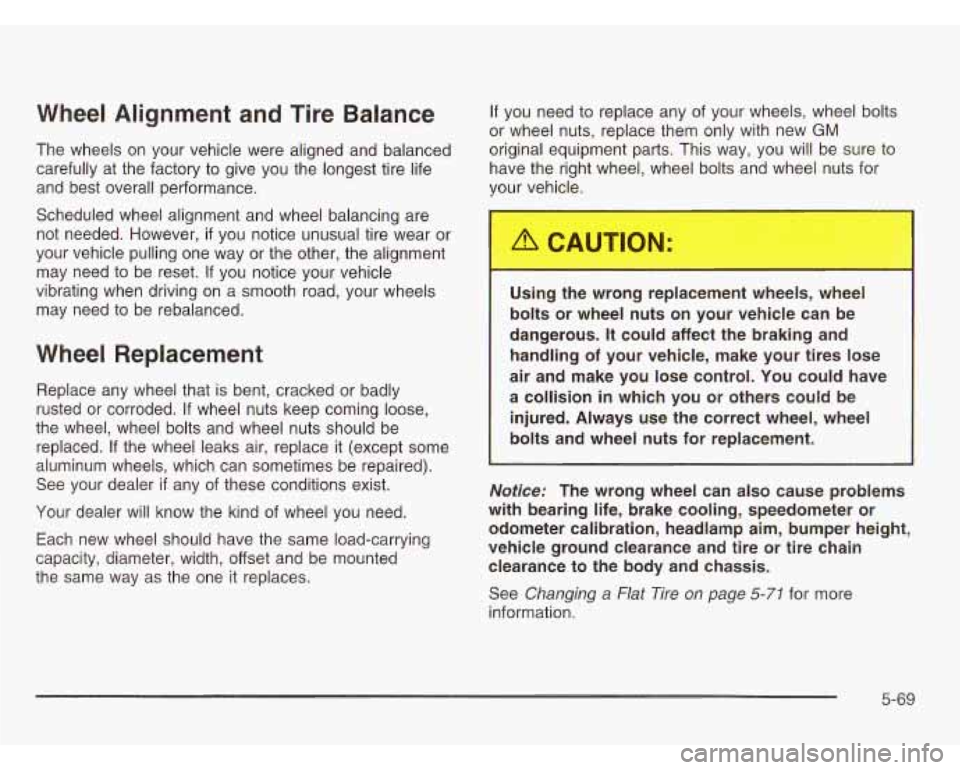
Wheel Alignment and Tire Balance If you need to replace any of your wheels, wheel bolts
or wheel nuts, replace them only with new
GM
The wheels on your vehicle were aligned and balanced original
equipment parts. This way, you will be sure to
carefully at the factory to give you the longest tire life have
the right wheel, wheel bolts and wheel nuts for
and best overall performance.
your
vehicle.
Scheduled wheel alignment and wheel balancing are
not needed. However,
if you notice unusual tire wear or
your vehicle pulling one way or the other, the alignment
may need to be reset.
If you notice your vehicle
vibrating when driving on a smooth road, your wheels
may need to be rebalanced.
Wheel Replacement
Replace any wheel that is bent, cracked or badly
rusted or corroded.
If wheel nuts keep coming loose,
the wheel, wheel bolts and wheel nuts should be
replaced. If the wheel leaks air, replace it (except some
aluminum wheels, which can sometimes be repaired).
See your dealer
if any of these conditions exist.
Your dealer will know the kind of wheel you need.
Each new wheel should have the same load-carrying
capacity, diameter, width, offset and be mounted
the same way as the one it replaces. the wrong replacement wheels, wheel
bolts or wheel nuts on your vehicle can be
dangerous.
It could affect the braking and
handling of your vehicle, make your tires lose
air and make you lose control. You could have
a collision
in which you or others could be
injured. Always use the correct wheel, wheel
bolts and wheel nuts for replacement.
Notice: The wrong wheel can also cause problems
with bearing life, brake cooling, speedometer or
odometer calibration, headlamp aim, bumper height,
vehicle ground clearance and tire or tire chain clearance to the body and chassis.
See
Changing a Flat Tire on page 5-71 for more
information.
-~
5-69
Page 316 of 386
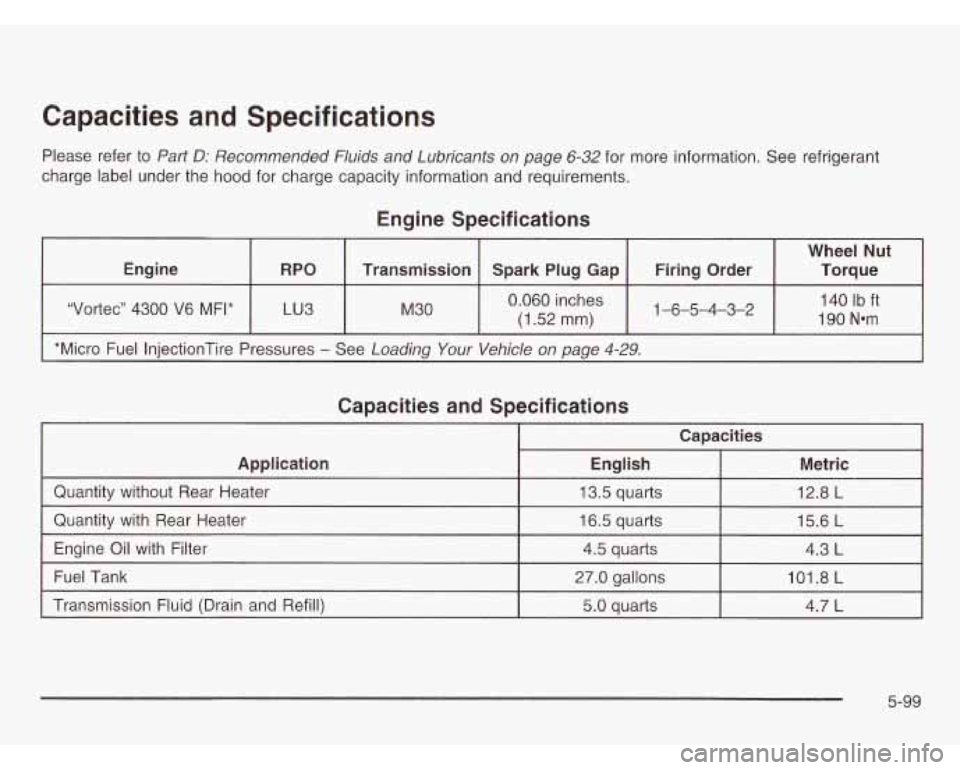
Capacities and Specifications
Please refer to Part D: Recommended Nuids and Lubricants on page 6-32 for more information. See refrigerant
charge label under the hood for charge capacity information and requirements.
Engine Specifications
“Vortec” 4300 V6 MFI* 1-6-5-4-3-2
I *Micro Fuel IniectionTire Pressures - See Loadina Your Vehicle on mae 4-29. I
Capacities and Specifications
I Capacities I
Fuel Tank I 27.0 gallons I 101.8 L
Transmission Fluid (Drain and Refill) 4.7 L 5.0 quarts
5-99